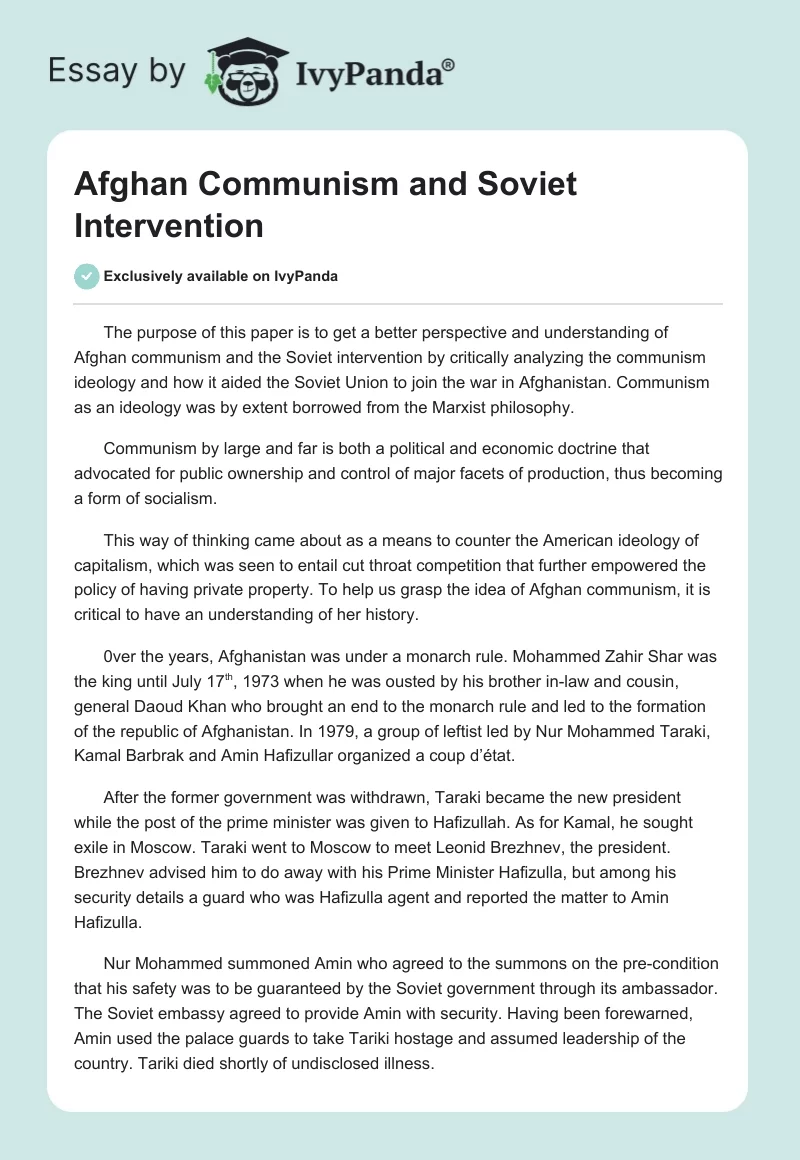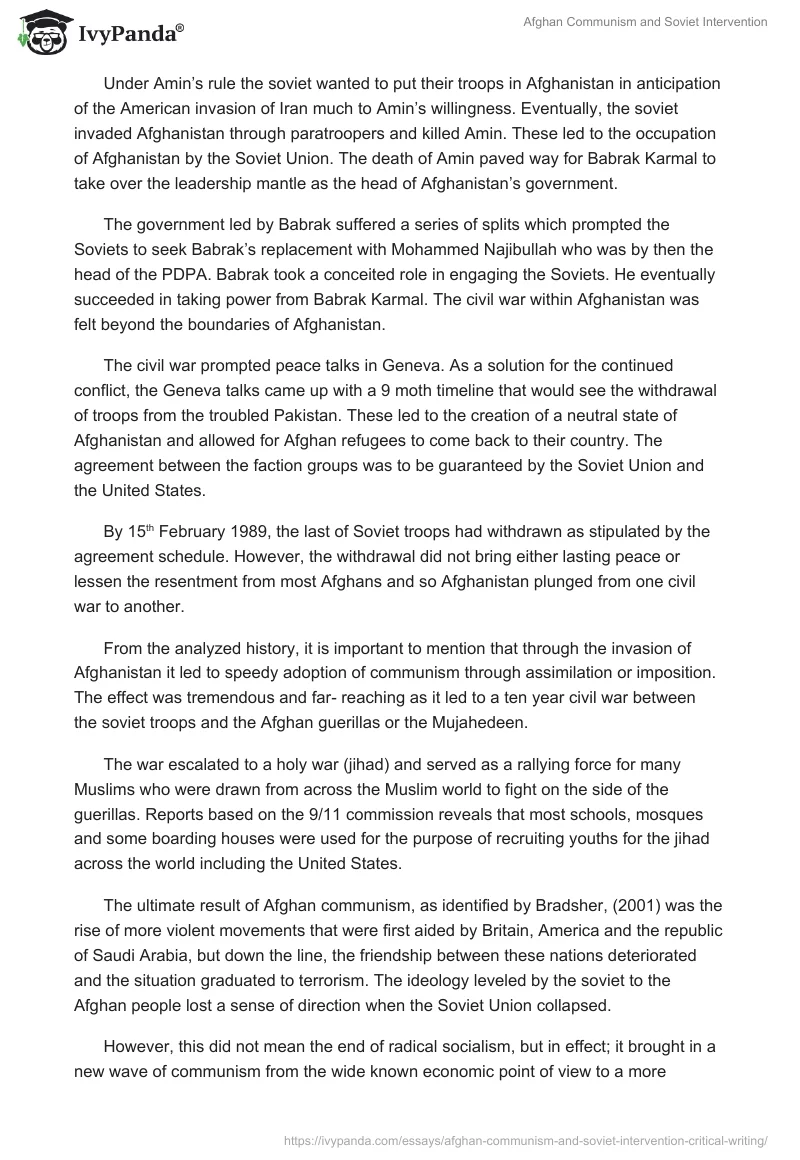The purpose of this paper is to get a better perspective and understanding of Afghan communism and the Soviet intervention by critically analyzing the communism ideology and how it aided the Soviet Union to join the war in Afghanistan. Communism as an ideology was by extent borrowed from the Marxist philosophy.
Communism by large and far is both a political and economic doctrine that advocated for public ownership and control of major facets of production, thus becoming a form of socialism.
This way of thinking came about as a means to counter the American ideology of capitalism, which was seen to entail cut throat competition that further empowered the policy of having private property. To help us grasp the idea of Afghan communism, it is critical to have an understanding of her history.
0ver the years, Afghanistan was under a monarch rule. Mohammed Zahir Shar was the king until July 17th, 1973 when he was ousted by his brother in-law and cousin, general Daoud Khan who brought an end to the monarch rule and led to the formation of the republic of Afghanistan. In 1979, a group of leftist led by Nur Mohammed Taraki, Kamal Barbrak and Amin Hafizullar organized a coup d’état.
After the former government was withdrawn, Taraki became the new president while the post of the prime minister was given to Hafizullah. As for Kamal, he sought exile in Moscow. Taraki went to Moscow to meet Leonid Brezhnev, the president. Brezhnev advised him to do away with his Prime Minister Hafizulla, but among his security details a guard who was Hafizulla agent and reported the matter to Amin Hafizulla.
Nur Mohammed summoned Amin who agreed to the summons on the pre-condition that his safety was to be guaranteed by the Soviet government through its ambassador. The Soviet embassy agreed to provide Amin with security. Having been forewarned, Amin used the palace guards to take Tariki hostage and assumed leadership of the country. Tariki died shortly of undisclosed illness.
Under Amin’s rule the soviet wanted to put their troops in Afghanistan in anticipation of the American invasion of Iran much to Amin’s willingness. Eventually, the soviet invaded Afghanistan through paratroopers and killed Amin. These led to the occupation of Afghanistan by the Soviet Union. The death of Amin paved way for Babrak Karmal to take over the leadership mantle as the head of Afghanistan’s government.
The government led by Babrak suffered a series of splits which prompted the Soviets to seek Babrak’s replacement with Mohammed Najibullah who was by then the head of the PDPA. Babrak took a conceited role in engaging the Soviets. He eventually succeeded in taking power from Babrak Karmal. The civil war within Afghanistan was felt beyond the boundaries of Afghanistan.
The civil war prompted peace talks in Geneva. As a solution for the continued conflict, the Geneva talks came up with a 9 moth timeline that would see the withdrawal of troops from the troubled Pakistan. These led to the creation of a neutral state of Afghanistan and allowed for Afghan refugees to come back to their country. The agreement between the faction groups was to be guaranteed by the Soviet Union and the United States.
By 15th February 1989, the last of Soviet troops had withdrawn as stipulated by the agreement schedule. However, the withdrawal did not bring either lasting peace or lessen the resentment from most Afghans and so Afghanistan plunged from one civil war to another.
From the analyzed history, it is important to mention that through the invasion of Afghanistan it led to speedy adoption of communism through assimilation or imposition. The effect was tremendous and far- reaching as it led to a ten year civil war between the soviet troops and the Afghan guerillas or the Mujahedeen.
The war escalated to a holy war (jihad) and served as a rallying force for many Muslims who were drawn from across the Muslim world to fight on the side of the guerillas. Reports based on the 9/11 commission reveals that most schools, mosques and some boarding houses were used for the purpose of recruiting youths for the jihad across the world including the United States.
The ultimate result of Afghan communism, as identified by Bradsher, (2001) was the rise of more violent movements that were first aided by Britain, America and the republic of Saudi Arabia, but down the line, the friendship between these nations deteriorated and the situation graduated to terrorism. The ideology leveled by the soviet to the Afghan people lost a sense of direction when the Soviet Union collapsed.
However, this did not mean the end of radical socialism, but in effect; it brought in a new wave of communism from the wide known economic point of view to a more political idealism that was now headed by the KGB. The Soviet Union had failed in its quest to spread their ideology which had also impacted on their economy negatively.
Communism had to change its face and this was brought to play by Yuri Andropov who took over the reigns of the KGB in 1967. This branch of the Russian security service was transformed to become an independent, fully fledged unit within the Soviet State.
Yuri Andropov also championed the financing activities for various uprisings in Europe, the Middle East and in Africa. These uprisings were initially started as student uprisings especially in northern Europe and in the Middle East. Yuri used a different approach; that of business, especially in oil which was meant to cut of the west especially America that depended on oil products imported from the oil rich gulf-region.
He was also pro-active in the formation of a group of young Muslim fundamentalist from the various Islamic countries who resided in America as either students or workers. Some of this recruits assisted to form the Muslim brotherhood movement.
What remains as the most controversial point in Afghan communism is the fact that the rise of Islamism militias lies squarely on both the infiltration by either the KGB or the CIA, with both parties rooting for their interest within Afghanistan and Pakistan. This is supported by the reports of personalities such as Gulbuddin Hekmatyar, a sympathizer and also a pro-active associate of the communist regime in Kabul.
The most shocking analysis about Gulbuddin Hekmatyar is how he ended up becoming an operative of the Pakistan ISI and even getting both financial and weapons from America in aid of the Taliban in the 1980s, despite being known for his support for the terrorist and his affiliation to militias in Iran. Others have suggested that this could only have been possible through the infiltration of the CIA by KGB.
Others have argued that the CIA lacked the intelligence to have foreseen the consequence of their involvement with these individuals who mostly tried to use the resources’ of the United States to expound on their agenda.
However, it is important to mention that not all socialist ideologists have contributed to this radical wave of violence; rather, it is the extremist side that has led to the formation on internal self-grown terrorists who are affiliated to these extremists.
To enhance this knowledge, it is critical to look at how the Taliban came to be. Taliban was established by Mullah Omar who was joined in 1984 by Osama bin Laden in Pakistan and took part in the 1987 battle. In autumn, of 1989 Bin Laden’s mentor, Massud, was assassinated and he took the reigns of al-Qaayd.
Osama sent most of the fighters at home and abandoned his base in the frontier town of Peshawar in the pretext that Saudi Arabia had issued a decree for his death.
By 1991, still the communists’ regime controlled and governed Kabul and when matters started to take shape in the Soviet Central Asia, Bin Laden changed his focus and apparent interests in destabilizing the Russian ideology and control to targeting pro-American governments’ supporters in Africa, and Europe.
Bin Laden only returned to Afghanistan through the invitation of Hikmatyar in 1996 to join him and also as a refugee, but to his shock, most of his allies had shifted together with the communist generals to Mullah Omar’s camp.
He also followed suit. All through the post-Soviet era, Russia misled the Afghan government of Burhanuddin Rabbani (1992-2001), of loyal support whereas most of its former commanders paid tribute to Hikmatyar.
Reference
Bradsher, H., S. (2001). Afghan Communism and Soviet Intervention. New Edition. New York: Oxford University Press, 2001.


